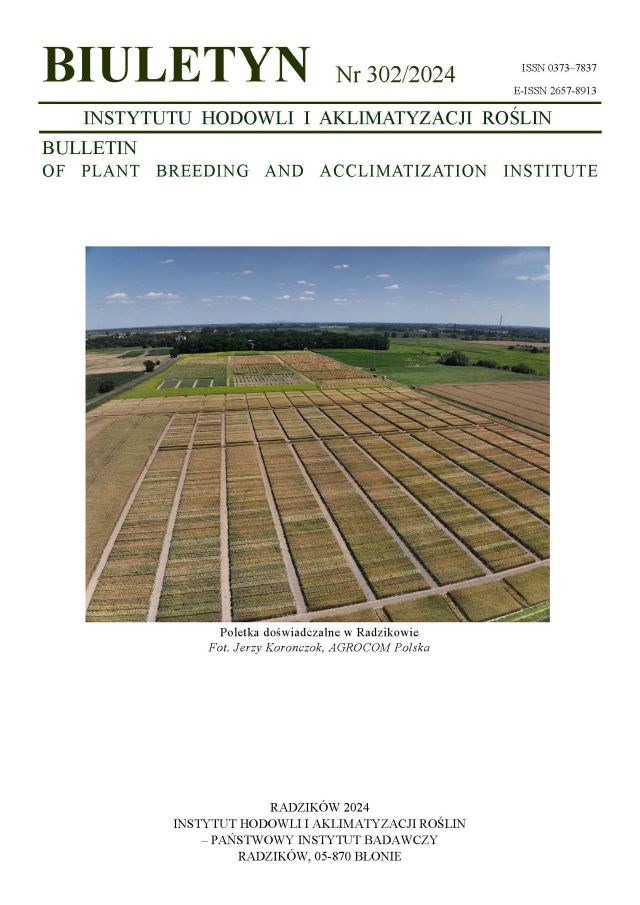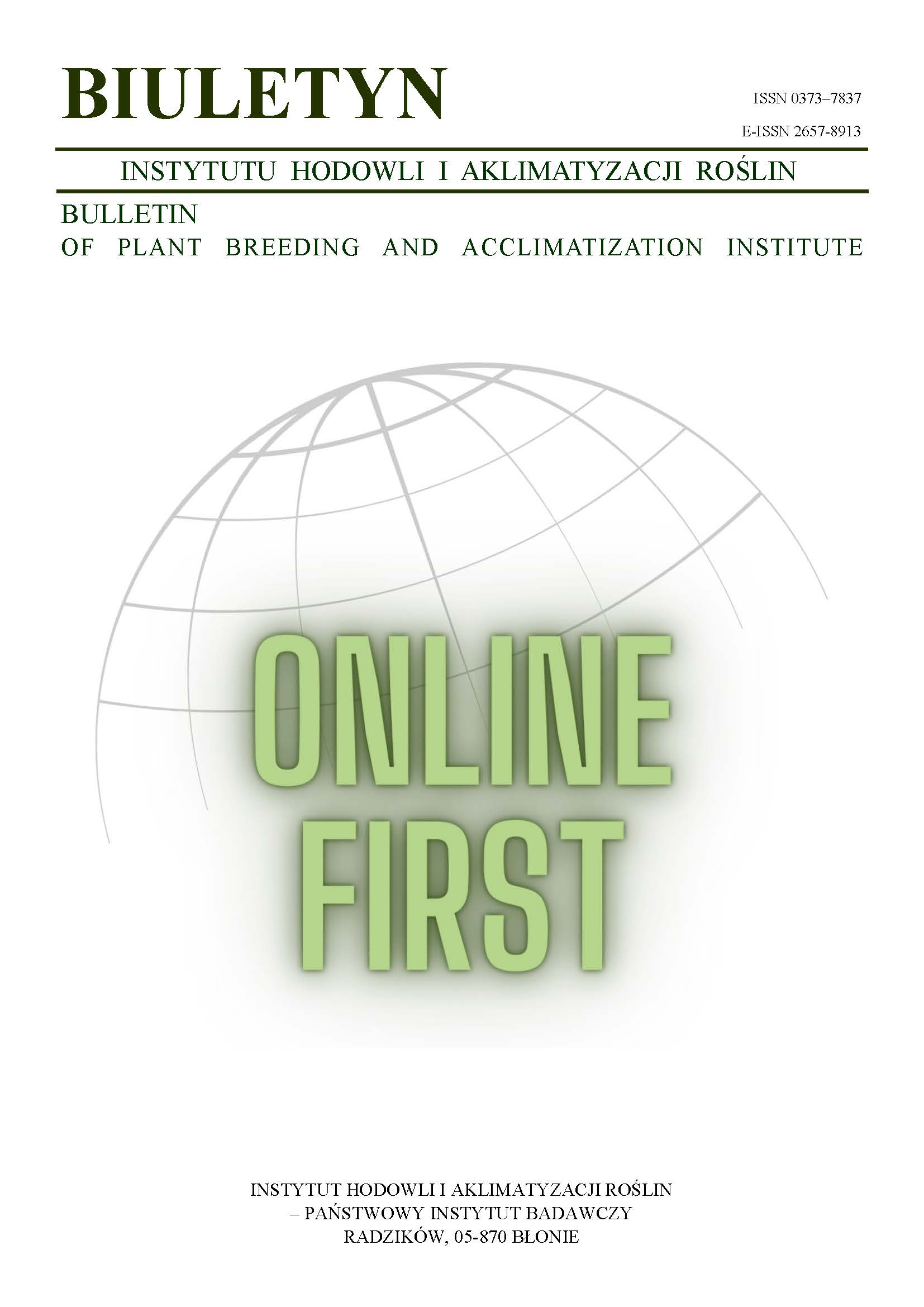The reasons of grain yield and quality variation in a production field of spring barley
Alicja Pecio
iung@iung.pulawy.plInstytut Uprawy Nawożenia i Gleboznawstwa, Puławy (Poland)
Krzysztof Kubsik
Instytut Uprawy Nawożenia i Gleboznawstwa, Puławy (Poland)
Andrzej Bichoński
Małopolska Hodowla Roślin HBP Spółka z o.o. Polanowice (Poland)
Abstract
The purpose of the study was estimation of spring barley grain yield and protein content variation on the area of production field and determination of the reasons for the variation. The studies were conducted in the Experimental Station Baborówko, Poland, in 1998–2003 on the fields where the methods of precision agriculture were used. It was found that the range of grain yield is determined by both weather and soil conditions and the range of protein content are dependent mainly on weather conditions. Canopy indices describing plant growth (plant number and dry matter yield, LAI values) and plant nitrogen nutrition status in the development stages until an thesis (N percentage in dry matter, NNI values for both maximal yield and optimal grain protein content, SPAD values) can be used for diagnosis of the crop status and prognosis of grain yield. The indices of plant nitrogen management during anthesis are useful for diagnosis and prognosis of grain protein content.
Keywords:
diagnosis, grain protein content, grain yield, prognosis, spring barley, variationReferences
Burger W. C., Wesenberg D. M., Carden J. E., Pawlisch P. E. 1979. Protein content and composition of Karl and related barleys. Crop Sci. 19: 235 — 238.
DOI: https://doi.org/10.2135/cropsci1979.0011183X001900020016x
Google Scholar
Justes E., Jeuffroy M. H., Mary B. 1997. Wheat, barley and durum wheat. In: Diagnosis of nitrogen status in crops. Ed. Lemaire G. Springer Verlag: 73 — 91.
DOI: https://doi.org/10.1007/978-3-642-60684-7_4
Google Scholar
Lauer J. G., Partridge J. R. 1990. Planting date and nitrogen rate effect on spring malting barley. Agron. J. 82 (6): 1083 — 1088.
DOI: https://doi.org/10.2134/agronj1990.00021962008200060011x
Google Scholar
Muller S. 1988. N uptake, yield and quality of malting barley in relation to inorganic soil nitrogen and N fertilization. Landwirtschaftliche Forschung. 41 (1–2): 99 — 108.
Google Scholar
Pecio A. Studia nad modelem rośliny i łanu jęczmienia jarego. IUNG Puławy, 1995, R (235): 1 — 84.
Google Scholar
Pecio A., Fotyma E. 2001. Calibration of NNI and SPAD tests for malting spring barley. Fragm. Agron. 3: 161 — 172.
Google Scholar
Słaboński A. 1976. Jęczmień jary i ozimy. PWRiL, Warszawa.
Google Scholar
Authors
Krzysztof KubsikInstytut Uprawy Nawożenia i Gleboznawstwa, Puławy Poland
Authors
Andrzej BichońskiMałopolska Hodowla Roślin HBP Spółka z o.o. Polanowice Poland
Statistics
Abstract views: 12PDF downloads: 10
License
Copyright (c) 2005 Alicja Pecio, Krzysztof Kubsik, Andrzej Bichoński

This work is licensed under a Creative Commons Attribution-ShareAlike 4.0 International License.
Upon submitting the article, the Authors grant the Publisher a non-exclusive and free license to use the article for an indefinite period of time throughout the world in the following fields of use:
- Production and reproduction of copies of the article using a specific technique, including printing and digital technology.
- Placing on the market, lending or renting the original or copies of the article.
- Public performance, exhibition, display, reproduction, broadcasting and re-broadcasting, as well as making the article publicly available in such a way that everyone can access it at a place and time of their choice.
- Including the article in a collective work.
- Uploading an article in electronic form to electronic platforms or otherwise introducing an article in electronic form to the Internet or other network.
- Dissemination of the article in electronic form on the Internet or other network, in collective work as well as independently.
- Making the article available in an electronic version in such a way that everyone can access it at a place and time of their choice, in particular via the Internet.
Authors by sending a request for publication:
- They consent to the publication of the article in the journal,
- They agree to give the publication a DOI (Digital Object Identifier),
- They undertake to comply with the publishing house's code of ethics in accordance with the guidelines of the Committee on Publication Ethics (COPE), (http://ihar.edu.pl/biblioteka_i_wydawnictwa.php),
- They consent to the articles being made available in electronic form under the CC BY-SA 4.0 license, in open access,
- They agree to send article metadata to commercial and non-commercial journal indexing databases.
Most read articles by the same author(s)
- Tadeusz Adamski, Andrzej Bichoński, Zdzisław Biliński, Zbigniew Bystry, Piotr Jarosz, Dorota Jasińska, Zygmunt Kaczmarek, Karolina Krystkowiak, Anetta Kuczyńska, Wojciech Mikulski, Barbara Nowak, Wanda Orłowska-Job, Zdzisław Paszkiewicz, Michał Rębarz, Maria Surma, Anna Sybilska, Renata Trzeciak, The genotype-environment interaction for barley lines from different breeding stations , Bulletin of Plant Breeding and Acclimatization Institute: No. 249 (2008): Regular issue
- Bogna Zawieja, Andrzej Bichoński, The selection of breeding lines of spring barley on the basis of statistical analysis of three year trial series , Bulletin of Plant Breeding and Acclimatization Institute: No. 275 (2015): Regular issue
- Alicja Pecio, Andrzej Bichoński, Nitrogen fertilization and fungicide application as the elements of spring barley production , Bulletin of Plant Breeding and Acclimatization Institute: No. 252 (2009): Regular issue
- Tadeusz Adamski, Andrzej Bichoński, Zdzis Biliński, Zbigniew Bystry, Piotr Jarosz, Dorota Jasińska, Zygmunt Kaczmarek, Karolina Krystkowiak, Anetta Kuczyńska, Wojciech Mikulski, Barbara Nowak, Wanda Orłowska-Job, Zdzisław Paszkiewicz, Michał Rębarz, Maria Surma, Anna Sybilska, Identifying suitable locations for evaluating advanced barley breeding lines , Bulletin of Plant Breeding and Acclimatization Institute: No. 247 (2008): Regular issue
- Maria Surma, Tadeusz Adamski, Andrzej Bichoński, Zdzisław Biliński, Zbigniew Bystry, Piotr Jarosz, Zygmunt Kaczmarek, Anetta Kuczyńska, Karolina Krystkowiak, Wojciech Mikulski, Jadwiga Nadziak, Wanda Orłowska-Job, Zdzisław Paszkiewicz, Michał Rębarz, Anna Sybilska, Phenotypic and genetic divergence of spring barley breeding lines , Bulletin of Plant Breeding and Acclimatization Institute: No. 236 (2005): Regular issue
- Andrzej Bichoński, Variation and genetic determination of some quality characters in winter wheat , Bulletin of Plant Breeding and Acclimatization Institute: No. 233 (2004): Regular issue
- Alicja Pecio, Krzysztof Kubsik, Andrzej Bichoński, Analysis of spatial variation of spring barley grain yield and protein content within a production field , Bulletin of Plant Breeding and Acclimatization Institute: No. 236 (2005): Regular issue














